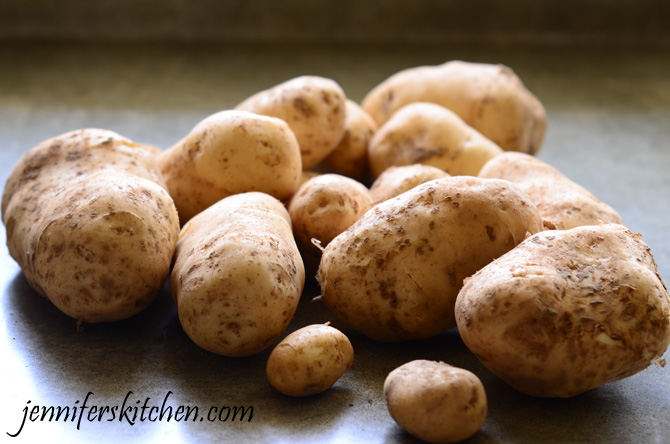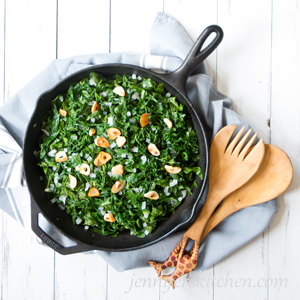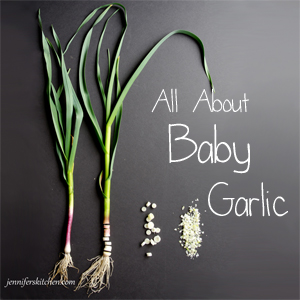Fresh Potatoes for Christmas Day
 There’s something very satisfying about being able to eat food from your garden when the weather outside is dreary and cold. And there’s nothing quite like freshly-harvested new potatoes for Christmas dinner.
There’s something very satisfying about being able to eat food from your garden when the weather outside is dreary and cold. And there’s nothing quite like freshly-harvested new potatoes for Christmas dinner.
How to Have Freshly-Dug Potatoes for Christmas
I’m not an expert gardener, so I’m not sure how to grow Christmas potatoes in other areas of the country, but in most of the growing zones 6 and 7 (Kentucky, Tennessee, Indiana, Virginia, West Virginia, Ohio, etc.) and maybe even as far as zone 5 (Michigan, southern Wisconsin, and Iowa), the process for planting a second crop of potatoes is much the same as with spring potatoes.
When to Plant Potatoes
The obvious obstacle to growing potatoes in autumn is cold and frost. While cool weather won’t hurt potatoes, a heavy frost will kill the plants and thus stop tuber growth.
The solution is to plant your second-crop potatoes early enough so that the tubers are formed before the plants are killed by the cold. I usually plant my seed potatoes in early August.
I also plant an early variety (like Yukon Gold or Caribe), since the early ones don’t take as much time to form tubers as late varieties do.
What About Frost?
When we get our first frost (usually early October, but sometimes late September) the foliage of the potato plants die, but the tubers stay nice and cozy underground until we’re ready to dig them.
We usually pile some old hay or straw or leaves on the potato beds to protect the ground from freezing until we’re ready to dig our potatoes. (Next year, that covering makes great compost!)
Good, Loose Soil
It’s important to grow winter-harvested potatoes in good, loose soil for a couple of reasons. The first is so you can easily dig them. This is especially important if you get a lot of rain or snow in early winter. Trying to lift potatoes out of muddy, heavy, clay soil in the freezing cold weather takes all the fun out of growing Christmas potatoes.
The second reason is to promote good drainage. One trouble with storing potatoes in the ground through the winter is that the wet soil can cause them to rot. We plant our potatoes on top of hilled-up soil to promote good drainage, and we usually don’t leave them in the ground past January. This method seems to work well for us.
 Where to Get Second-Crop Potato Seed
Where to Get Second-Crop Potato Seed
You don’t need a special kind of seed potato to grow winter potatoes; you can use the same kind you would use for spring planting. (Just be sure you choose a variety that matures quickly.)
I’ve heard that seed suppliers store seed potatoes in a particular way so they can offer seed potatoes specially for growing second-crop potatoes. But my summers are so busy the last thing on my mind in the middle of the hot months is ordering seed potatoes. In addition, I’ve tried several suppliers for potato seed but haven’t found one that I’m completely happy with yet. (Any suggestions are welcome.)
So when I harvest potatoes in the summer and fall, I just set some aside for both spring and autumn planting the next year. And come December, we are enjoying delicious Christmas potatoes. : )
Do you like to winter garden? What are your favorite vegetables to grow in the winter?
Popular Posts
You my also like:
Before you go . . .
Did you know that you can eat all this delicious food AND lose weight? You can!
No calorie counting. No portion sizes.
Join my online weight loss program today!








I’m in California (foothills between ‘Frisco and Tahoe). We grow them year ’round. They just keep going and going. Nothing better than little potatoes for breakfast. They don’t get as large as the grocery store spuds but they’re tasty, none the less.
That would be wonderful! Wish we could do that!
Great to hear! We are in Auburn and I was hoping we could grow them year-round. Thanks for confirming it! 🙂
I don’t think “early” potatoes mean they ripen quicker. I think it means WHEN they want to be planted. I think you should plant Early potatoes in April, and a Late variety in August. It has to do with the length of day getting longer, or shorter, for them to form tubers. Check out The complete Book of Potatoes. Scott